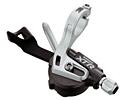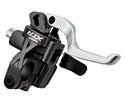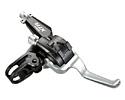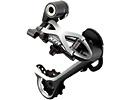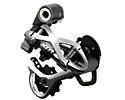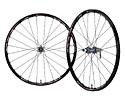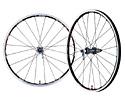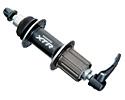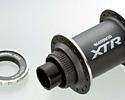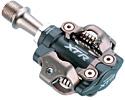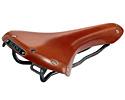
Recently on Cyclingnews.com |
Tech News – April 3, 2006Edited by John Stevenson Got tech? Send press releases, news, and tech questions to the Cyclingnews tech desk. 2007 XTR: Shimano reveals official detailsOptions abound as Shimano expands appeal of M970 beyond cross-country racingBy James Huang Without a doubt, "choice" is the key message of Shimano's upcoming 2007 XTR package, scheduled to be released around October. XTR is still intended to be Shimano's ultimate cross-country racing group, but the new M970 version seeks to broaden the scope of appeal to a much more diverse market. In Shimano's eyes, mountain bikers fall into two distinctly different categories: those who ride up and down the mountain, and those who just ride down. Specifically, the riders in the former group for whom super lightweight, yet reasonably durable, components are appropriate are the ones that Shimano has targeted with its new top-tier offering. Going both "up and down the mountain" is an incredibly vague description that means a lot of different things to a lot of different people. Cross-country racing certainly fits in there, but so does all-mountain and general trail riding, and it would be a tall order to satiate all of those climbing and descending masses with a single group. In this case, however, it sounds like Shimano may have done its homework and given itself a fighting chance at fulfilling the goal. According to Dave Lawrence, marketing manager for Shimano's bicycle components division, "Pure cross-country is not what it used to be. With M970, we have tried to truly understand how people are using the product, and what we found out is that they want choices. One size does not fit all and we want to make sure all styles of riding are covered." The list of options for M970 reads longer than your typical fast food menu with items including a 20mm through-axle front hub, four different disc brake rotor sizes, two wholly different styles of shifters as well as both low normal (a.k.a. "Rapid Rise") and top normal rear derailleurs in two different cage lengths. Now, not only can you have fries with that, but you have your choice of curly or regular, or spicy or plainly salted. Oh, you want mustard, too? Sure, would you like Dijon or yellow? The look of the group as a whole (as least for what we've seen so far) has a hyper-industrial flavour to it, and the icon of the new kit is a simple "X" which is boldly incorporated into just about every component. (And that has already had wags making remarks about bike parts for the next X-Men movie.) Whether or not you like the look, few will argue that Shimano is playing it safe with XTR from a design standpoint and at least deserves some credit for taking a big risk with the appearance. Rapidfire Plus shiftersAs discussed earlier the new trigger shifters incorporate a wealth of new features, but we can now provide official names to go along with them as well as a surprise or two. The option to either pull or push the release lever (the current lever can only be pulled with the index finger) has been named 'Two-Way Release' while the ability to knock off two gears with a single sweep of that same lever in either direction has been termed 'Multi Release'. In addition, 'Instant Release' now refers to the ability of the forward lever to release cable immediately when the lever is actuated as opposed to the current configuration where the cable unspools only after the lever is released after being pulled. In combination, Two-Way Release, Multi Release, and Instant Release promise to greatly increase shifting speed over Shimano's current Rapidfire Plus shifters. Positioning flexibility has also surfaced as a high priority for the Shimano design team. The new low-profile shifter clamp can be mounted either inboard or outboard of the brake levers and the shifter pod itself can now be moved laterally relative to the clamp for even more customization. Comparisons between the new triggers shifters and SRAM's design are sure to surface, but time will tell just how similar the two designs are in use. Dual Control leversThe first generation of Dual Control levers seemed to get a fairly mixed reception in the marketplace, but Shimano maintains that there is a core group of riders that prefer them over trigger shifters and it did not want to disappoint the flippy shifter faithful by only offering a new trigger. In keeping with its goal of offering riders a multitude of choices, Shimano will introduce two wholly revamped sets of XTR Dual Control levers, one for cable-actuated brakes and the other for hydraulic disc brakes. The most striking feature is the new look of the levers, but Shimano has also dramatically reduced their overall length. This was a definite issue with the previous generation of Dual Control when they were mounted on a narrow handlebar (plus the unnecessarily long form looked a bit odd) so this is a welcome change. The new levers will also incorporate Shimano's Multi Release and Instant Release technologies to speed up shifting. Rear derailleursChoice is again the theme here, as the new XTR rear derailleur will be offered in both Low Normal and Top Normal varieties as well as in both mid- and long-cage versions. Shimano suggests that the Low Normal variety be pared with their Dual Control levers and Top Normal with their triggers, but as with the previous generation, any combination of the two will work. The 'X' logo is heavily integrated into the design here, and although Shimano has yet to quote any weight figures, the images suggest a significant weight reduction with the pared-down parallelogram and drilled out inner pulley cage plate. Parallelogram links have also been widened for greater rigidity which should produce more precise shifts. As with the previous RD-M960 model, the new XTR rear derailleurs have no cable adjusters. A derailleur-mounted adjuster is a bit redundant since there is one on the shifter, and eliminating it removes a common failure mode from the derailleur and, undoubtedly, drops a bit of mass from the changer. Wheels and hubsShimano's XTR wheels are entirely new for '07 and, for the first time, Shimano will offer a rim-brake compatible version. Both wheelsets feature tubeless-compatible scandium rims with reinforced spoke holes laced with 24 double-butted (2.0/1.5/2.0mm) spokes front and rear. Shimano has also redone the hubs for XTR, including those used in the complete wheelsets. Oversized aluminum axles are used throughout, and the new titanium freehub body incorporates a 36-point ratchet ring for a dramatic improvement in engagement speed. One of the biggest signs that Shimano has opened up the scope of XTR is the introduction of a 20mm thru-axle front hub. Cross-country racers undoubtedly will still choose the standard quick-release version, but the new 20mm hub will finally offer up an XTR-level front hub to those riders seeking a more rigid front end. All of the disc-compatible hubs use Shimano's standard non-oversized Center Lock rotor mount. This includes the new 20mm front hub, unlike the Hone and Saint groups which use a different Center Lock pattern. In somewhat atypical fashion, though, Shimano has added a bit of 'bling' to the separately available hubs in the form of high-polished flange lips. Yow. CassetteCassettes are certainly not the most exciting bit of componentry around, but lighter, stiffer, and quality shifting are the keys here and the new XTR cassette promises all three. Shimano has reverted back to the original multi-piece aluminum spider of the first 9spd XTR group where only two cogs were attached to each carrier unlike the current generation where one large spider is used. In this case, three separate aluminum carriers increase cassette rigidity by a claimed 100%, and the largest four cogs are titanium. Needless to say, Shimano's Hyperglide tooth-shaping technology will carry over to guarantee excellent shifting. The new cassette is the only component for which a weight has been quoted, and Shimano says an 11-32T version will hit the scales at just 224g complete. PedalsAs promised, XTR finally receives its own pedal. As compared to the rest of the group, the new PD-M970 pedal appears rather pedestrian and also very similar to the current M959 pedal. The new pedal manages to drop down to 324g for the pair, however, yet also promises to be more rigid. Additionally, the now-ubiquitous SH51 SPD cleat soldiers on unchanged. Crankset and brakesShimano has yet to release official information on the new crankset and brake offerings, but spy images that recently surfaced on a Dutch web site appear to confirm some of the rumors. As has already been reported elsewhere, the new XTR crankset will (thankfully) share chainring compatibility with XT and LX. It had also been confirmed earlier that the middle chainring will be a hybrid carbon fiber-and-titanium affair, but the spy image suggests that this may be the case with the outer ring as well. Regardless, Shimano's now-proven Hollowtech II external bearing bottom bracket design will carry over. Shimano has already confirmed that four rotor sizes will be available for XTR: 203mm, 180mm, 160mm, and a XC rear-specific 140mm rotor. According to the spy images, however, some (or all) of the rotors will now consist of a stainless steel braking surface mounted on a very minimalist aluminum spider. The disc brake caliper itself also appears to have gained some oil volume for enhanced heat capacity. Industry sources had previously informed Cyclingnews that a separate XTR hydraulic disc brake lever will be introduced with the new group as well and Shimano has posted an image of the new lever on its own web site. As suspected based on the Dual Control redesign, the new lever will incorporate a compact radial master cylinder design and appears to use an aluminum lever. Time to turn things aroundM970 not only is new kit, but also signifies what appears to be a paradigm shift in Shimano's approach to new product introduction. Shimano has clearly spent a lot of time and energy in an effort to discover what riders really want, rather than take it upon itself to propose what Shimano thinks people want. To be sure, Shimano, as a whole, is a rather gargantuan corporation and a lukewarm reception of its upcoming XTR kit won't make or break it. However, Shimano has clearly been taking a bit of a beating in the high-end MTB marketplace and a lot is riding on the success of the new group, if only in terms of public perception. For Shimano's sake, and for that of the general mountain biking public, let's hope that the new XTR is everything it's cracked up to be. Based on the information we've received so far, though, things are looking pretty good.
First Endurance tweaks sports drinkSupplement maker First Endurance has tweaked the flavour of its sports drink. Formerly known as E3, the drink now known as EFS (for Electrolyte Fuel System) is available in lemon-lime flavour that First Endurance says is about 15 percent sweeter and more tart than before. "We changed the flavour of Lemon-Lime because of feedback we received from our athletes and retailers," says First Endurance's Mike Fogarty. "The feedback on the new Lemon-Lime is that it's the best tasting endurance drink they've ever tried." Fogarty adds that EFS' unique feature is that it contains all five electrolytes in the levels endurance athletes need to stay hydrated and prevent cramping, so there's no need to add anything to your energy drink or use electrolyte pills. More info: www.firstendurance.com
Brooks brings back the SwallowIt must be summer…Legendary leather saddle maker Brooks (now owned by Selle Royal) has announced the return of an equally legendary seat, the Swallow racing saddle. Last year, Brooks produced a limited edition of 999 Swallow saddles, and, the company says, they sold out in weeks. To satisfy the remaining demand Brooks has recreated the Swallow as the Classic Swallow. This saddle replicates the narrow, cutaway shape of the original 1936 Swallow, a saddle which was extremely popular with racers in the middle of last century until lighter, foam-covered, plastic-hulled saddles displaced Brooks from its perch. To keep the weight of the modern version under control it has titanium rails and to keep the cost under control the leather is not stitched together, a process that contributed to making the old Champion Swallow the most expensive saddle Brooks ever made. Even with the titanium rails, the Swallow is unlikely to appeal to weight weenies - making a saddle from a single piece of leather is a weighty process. But that's not the point. Brooks is bringing back a piece of history here. Bottecchia, Bartali, Coppi and Anquetil all rode Brooks saddles and the Swallow shape was almost certainly the inspiration for modern minimalist saddles. More info: www.brooksengland.com
Mountain Cycle up for saleFrom a reborn legend to one in troubled times. Mountain bike manufacturer Mountain Cycle is for sale after parent company Kinesis laid off most of its Portland, Oregon based staff and management last month, according to a report from Bicycle Retailer. "When it was started in 1987, Mountain Cycle pioneered motocross-inspired monocoque suspension frames for the emerging downhill MTB scene," said Michael Chen, Mountain Cycle's president in a statement. "After a string of misguided niche-market introductions like our road and cyclocross frames, Mountain Cycle's core customer didn't recognize the brand any more." Kinesis is reported to be in talks with several potential buyers for Mountain Cycle, and hopes to announce a new owner as soon as Sea Otter, later this week. In the late 80s and early 90s, Mountain Cycle, under founder and chief designer Rob Reisinger, was a pioneer in the development of mountain bikes. The company's San Andreas bike was a unique combination of long suspension travel, a welded, clamshell aluminium monocoque frame, disc brakes and an upside down fork. Kinesis bought Mountain Cycle in 2002.
|

